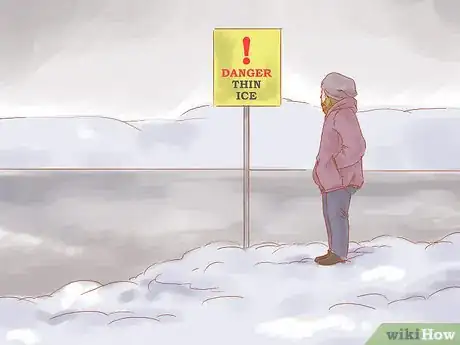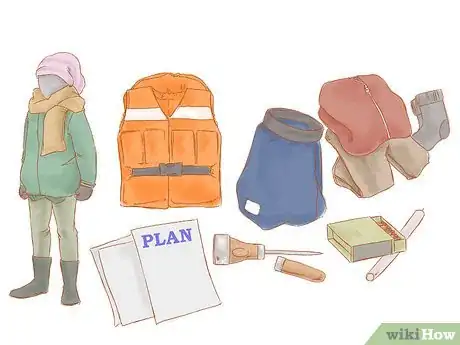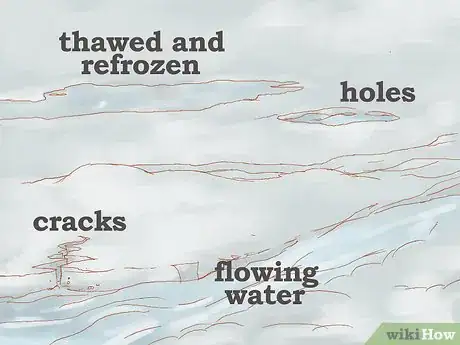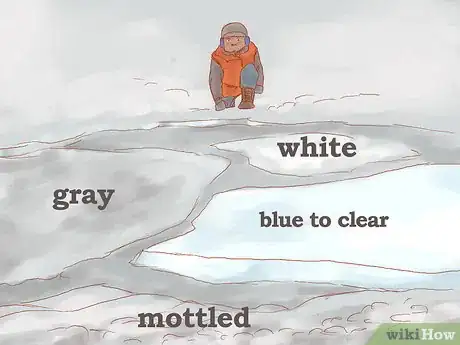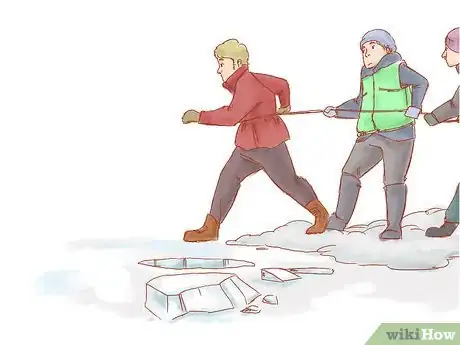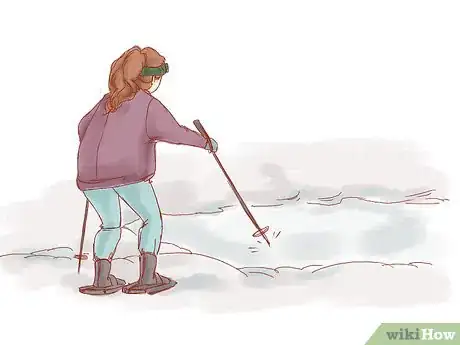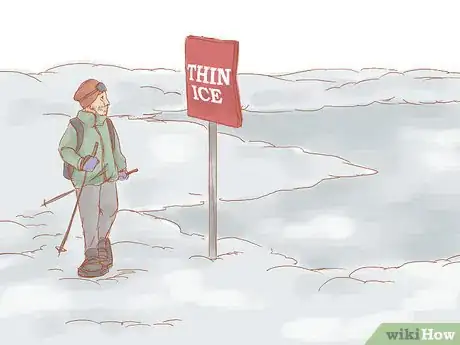wikiHow is a “wiki,” similar to Wikipedia, which means that many of our articles are co-written by multiple authors. To create this article, 47 people, some anonymous, worked to edit and improve it over time.
This article has been viewed 670,816 times.
Learn more...
Walking, snowshoeing, snowmobiling, ice fishing (with or without a car), cross-country skiing,skating,and playing sports are dangerous pastimes when you don't know how to tell if ice is thick enough to withstand weight. There are ways to assist in gauging the potential safety of ice, such as observing its color, testing its thickness and being aware of external factors such as temperature, local conditions and local knowledge. However, no sport undertaken on ice over water bodies is ever without risk. If in doubt, do not go onto the ice; moreover, it never pays to be too early or too late in the season.
Steps
-
1Recognize that ice will never be completely safe. Conditions and unseen or unknown factors can render seemingly safe ice suddenly dangerous. Take all care and precautions to avoid mishaps and to put rescue plans into immediate action should something go wrong.
-
2Create an emergency safety plan. Tell people where you are going. If something does go wrong while you are testing or recreating, already have in place the safety procedures that you will carry out for immediate rescue.
- For starters, you should be adequately dressed in full cold weather attire. Wear some form of flotation device, even a boating life-jacket, especially if you are testing or snowmobiling. Carry an ice-pick which can assist in giving you grip should you fall in. Never go without a buddy or two. Tell other people where you and your buddy are and what time you expect to return home. This is not an occasion for casual spontaneity.
- Have a spare set of warm dry clothes in a waterproof bag handy. That way you can reduce the risk of hypothermia by changing the wet clothes immediately. Other useful supplies to have as part of an emergency kit include an emergency blanket, hand and foot warmers, thick socks, spare tuques, candles and matches. Pack such emergency items for all winter sports outdoors, even for skating outdoors. See "Things You'll Need" for further information.
Advertisement -
3Recognize that determining the safety of ice is dependent on a combination of factors, not on one factor alone. Ice safety is determined by assessing the following factors together:
- Appearance of the ice - its color, texture and features
- Thickness of the ice - there are recommended thicknesses for different uses, which are set out below
- External temperature over a period of time and on the day
- Snow coverage
- Depth of water under ice
- Size of water body
- Chemical composition of water - whether water is fresh or salt
- Local climate fluctuations
- Extent of ice
-
4Prefer ice that is checked by designated authorities on a regular basis. Such authorities may be staff at resorts, clubs or national parks or they may be government officials. At a minimum, such checking should occur daily. Ask them about their procedures if you need to know more to satisfy yourself. In the main, they will have access to quality measurement tools and procedures, along with full training in dealing with ice and ice accidents. This will save you the risk of testing and can reassure you. Nevertheless, continue to take all safety precautions.
-
5Ask the locals. If you're from "outta town", don't make any assumptions. Stop at the grocery store, bait shop, local ski store and have a chat, or even drop into a police or fire station and ask questions about the known danger spots and safer spots in the area. People would rather help you out now than have to haul you out later.
-
6Observe the ice. Look at the ice to see if you can see any cracks, breaks, weak spots or abnormal surfaces and to identify the color(s) of the ice. You cannot rely on your eyesight alone. This is just an initial look to help you to decide if it is even worth proceeding to the next step of testing the ice.
- If you see any of these signs, you may wish to abandon any further attempt to go on the ice:
- Flowing water near or at the edges of the ice
- Flowing springs under the ice in spring fed ponds and lakes.
- Water flows in and/or out of the iced-over water body
- Cracks, breaks or holes
- Ice that appears to have thawed and refrozen
- Abnormal surfaces that you have not seen before - e.g., pressure ridges caused by currents or winds
- Remember this ditty: "Thick and blue, tried and true; Thin and crispy, way too risky."
- If you see any of these signs, you may wish to abandon any further attempt to go on the ice:
-
7Know your ice color meanings. Although a useful indicator, color alone should not be relied upon. For instance, ice of any color subjected to a running water force underneath will be weaker than ice not subject to that pressure. In general, you can surmise the following from ice colors:
- Light gray to dark black - Melting ice, occurs even if air temperature is below 32°F (0°C). Not safe, its weak density can’t hold a load, stay off.
- White to Opaque - Water-saturated snow freezes on top of ice forming another thin ice layer. Most times it’s weak due to being porous from air pockets.
- Blue to Clear - High density, very strong, safest ice to be on if thick enough, stay off if less than 4 inches (10 cm) thick.
- Mottled and slushy or "rotten" ice - not so much its color but its texture. This ice is thawing and slushy. It is deceptive - it may seem thick at the top but it is rotting away at the center and base. Most prevalent in spring, may be showing signs of browns from plant tannins, dirt and other natural materials that are resurfacing from thawing. Not suitable for even a footstep.
-
8Test the thickness of the ice. If you have already made your observations and you still feel confident, you will need to back this up by checking the thickness of the ice.
- Test with at least one other person (the buddy system). Wear a flotation suit or device and use ropes that your buddy can pull on if something goes wrong.
- Only go on the ice if the edge of the water body is firm. If it is slushy or cracking, it is unlikely to be safe to proceed as shoreline ice is the weakest.
- Chip the ice with an axe or hatchet to create a small hole in the ice, or use an ice auger (a special tool which drills into the ice), for measuring the thickness through. Use a measuring device to determine the thickness.
- Learn the thickness safety margins of ice. There are recommended thickness measurements for the safety of ice that you will need to establish to for each activity being undertaken. (N.B. These are recommended, not guaranteed.) Ice begins to be "safe" at around 4 - 6 inches thickness. Do not even walk on ice 3" or less in thickness. However, even at a 9" - 10" thickness, there may be unforeseen hazards such as a flowing current underneath that is ceaselessly weakening the underside of the ice. In this instance, even the thickness is not a good indicator of safety, as the ice could collapse at any time.
- In general, the rules for ice thickness measurements are:
- 3" (7 cm) (new ice) - KEEP OFF
- 4" (10 cm) - suitable for ice fishing, cross-country skiing and walking (approx. 200 pounds)
- 5" (12 cm) - suitable for a single snowmobile or ATV (approx. 800 pounds)
- 8" - 12" (20 - 30 cm) - suitable for one car, group of people (approx. 1500 - 2000 pounds)
- 12" - 15" (30 - 38 cm) - suitable for a light pickup truck or a van
- These are commonly cited measurements.
-
9Understand that ice strength is not the same everywhere, not even on the same body of water. The strength of ice is also affected by factors other than color and thickness. Also take into account:
- Location of the ice: is it on a pond, a lake, a stream or is there evident flowing water underneath it? Is there a flow into or out of the water body? This will give cause for concern.
- Constitution of the water: is it fresh water or saltwater? Sea ice tends to be weaker and needs greater thickness to support the same weight as fresh water. See the External Links below for more information on exact measurements.
- External temperature and season: temperature changes constantly. Beware microclimates in the local area. Mid-winter ice is bound to be a lot stronger than spring ice which is subject to rapid thawing and warming bouts of sunshine.
- Size and depth of the water body: larger bodies of water take longer to freeze than smaller ones.
- Presence of snow on the ice: snow can warm up the ice because it acts as an insulator; ice under snow is generally thinner and weaker than ice without snow.
- Weight on ice: what are you putting on the ice? Just you or you and a vehicle? There is a big difference in the weight distribution between a body and a snowmobile with said body on top.
-
10Find alternatives if in any doubt. Skaters can always find a rink or a supervised lake area; snowmobilers and skiers can always stick to trails on land in place of crossing ice; walkers can keep off the ice and continue with their snowshoes along the trail. All out-goers should carry emergency supplies no matter how long they plan to be out nor where they plan to go.
Community Q&A
-
QuestionWhat are different ways to test ice safely?
 Community AnswerFollow the instructions listed in the article above.
Community AnswerFollow the instructions listed in the article above. -
QuestionIs 3 inches of ice safe enough for ice fishing?
 Community AnswerNo, 3 inches isn't really safe enough for anyone.
Community AnswerNo, 3 inches isn't really safe enough for anyone. -
QuestionIs it safe to ice skate on 3 inches of ice?
 Community AnswerNo, anything under 4 inches should be avoided at all costs. Even if it is above 3 inches, you should have safety gear.
Community AnswerNo, anything under 4 inches should be avoided at all costs. Even if it is above 3 inches, you should have safety gear.
Warnings
- Just because the area of ice you tested appears safe, this does not ensure that somewhere in a different part of the same water body will be safe. If you intend moving beyond the area you have tested, you should test again, or delimit the area that you will use.⧼thumbs_response⧽
- This article is applicable to very cold climate countries and regions such as Canada, upper USA and Russia. If your country or region does not normally experience deep winter conditions, consider your ice to be unsafe at all times and do not attempt to perform any of these activities on it without professional advice, preferably from a local government body authorized to provide such advice.⧼thumbs_response⧽
- Don't assume a very cold snap will be safe. This can actually render the ice brittle and liable to breakage much faster than a warm spell. Always check.⧼thumbs_response⧽
- Never drink during winter sports - wait until you're back in the chalet or your home. Alcohol can impair snowmobile driving, the reaction time and the ability to deal with an accident. Alcohol does not help relieve cold; it actually makes things worse and can lead to hypothermia.⧼thumbs_response⧽
- Snowmobilers should take care not to drive too fast - if they can't see what is up ahead, they may very well drive into a hole because they can't stop in time. Moreover, vehicles have little to no traction on ice and having to make a sudden turn away from a hole may not be possible. Spinning will be more likely and you may slide into the hole. Stay on the land and snow instead.⧼thumbs_response⧽
- In an emergency, if ice breaks under your snowmobile, do not stop. A snowmobile may be able to cross a limited amount of open water if momentum is kept up. This is do to the paddle wheel effect of the track spinning and the skis displacing water at speed. Instead, make a gentle arcing turn that allows you to keep plenty of momentum getting back to land or safe ice. A higher to full throttle setting keeps the track paddle wheeling through slush or water.⧼thumbs_response⧽
- If you are following a ski or snowmobile trail, do not use ice-covered streams, rivers, ponds or lakes as a shortcut unless it has been officially designated as a shortcut by local authorities who test it every day. Shortcuts are often taken at the end of day when the sportsperson is tired and just wants to get home and the light is dimming; it is also often when an accident happens precisely because you are tiring. Also, the day's warmth has worked on the ice by day's end, so ice is weakest at this time.⧼thumbs_response⧽
- Never walk, skate, play on, ski over or snowmobile over ice at night. You will not be able to see anything if something does go wrong and rescue help is much less likely to be around.⧼thumbs_response⧽
- Never drive a vehicle onto ice unless the ice has been professionally tested and passed as safe. Even then, breaking through still happens sometimes. If you must drive, you can prepare for problems by not driving too fast, leaving down windows (turn the heater up if it bothers you!) and unbuckling your seatbelt.
- Make sure you know how to escape from a sinking car, and that you have discussed emergency procedures with all passengers.
- When driving on ice, drive slowly, especially when approaching shore. Why? The weight of the vehicle--be it snowmobile, car or truck--presses the ice down. As you advance, this sets up a small but significant wave motion that precedes you across the ice. This wave can reflect off the shore you are approaching. Depending on your weight and speed these conditions can cause even thick ice to fail.
- Avoid crossing ice in a vehicle with children unless there is simply no alternative for emergency reasons. You will not have the time to deal with their needs as well as yours while disentangling yourself from a sinking machine.
⧼thumbs_response⧽ - Never intentionally cross unsafe ice with a snowmobile. It is an invitation for disaster for a person following your tracks. The water spray in the motor compartment can also sometimes stall the engine. Some states have made snowmobile open water crossing illegal.⧼thumbs_response⧽
Things You'll Need
- Rope
- Pickaxe, ice axe, awls
- Flotation suit or flotation devices that attach to the body
- Waterproof flashlight
- Waterproof matches
- Emergency blanket
- Spare change of clothes in waterproof bag
- Ice auger, saw, knife or other cutting implement for ice testing
- Measurement device
- Mini first-aid kit (watertight)
- Cellphone
- High energy food (e.g., bars, nuts, and little snacks)
- Hand warmers, feet warmers
- Toques (warm woolen hat), other hats, masks
